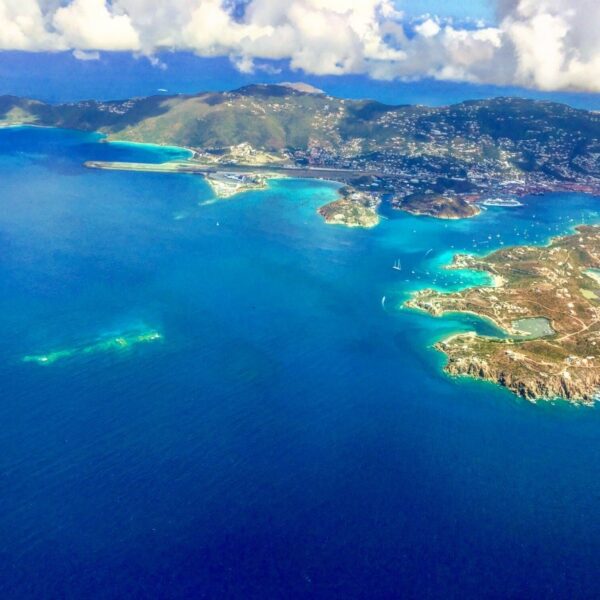March 2018

Hurricanes Irma and Maria smashed into the United States Virgin Islands within two weeks of each other, Irma on September 6, 2017, and Maria on September 20th. Both registered as Category 5 hurricanes, with Irma laying claim to the strongest winds ever recorded in an Atlantic hurricane, with speeds topping 190 miles per hour. The devastation was incredible. Homes were dismantled as if a bomb had gone off. Entire roof systems flew away, block walls crumbled, metal framing twisted and sheered, and the island’s vegetation was ripped from the ground or stripped bare. That was six months ago and the recovery is still underway.
I looked online for a non-profit, mission-type group to volunteer with. For personal reasons, I sought groups with no religious connections, just a group to help. I found All Hands and Hearts and read about their start and their work around the globe. David Campbell started the organization after traveling to Thailand after the devastating Indian Ocean tidal wave there impacted his soul. He began All Hands.
In the last year, All Hands has joined with a supermodel, Petra Nemcova, whose fiancé was killed in the Thailand tidal wave. The group is now All Hands and Hearts. They have camps in St. Thomas, St. John, Tortola, Puerto Rico, Dominica, and the British Virgin Islands in the Caribbean, as well as Peru, Nepal, Mexico, & Texas. Group volunteer numbers vary significantly.
During my three weeks in St. Thomas our volunteer numbers fluctuated between 50 and 80 people with a meagerly paid staff of about 8 or 10. Volunteers decide their time of work and submit an application with their information. Some volunteers stayed as little as three days, others had been there for months. The average stay, I would guess, was about one month. several college groups came and left within 5 days, giving up their Spring Break beach parties to volunteer and get filthy dirty every day cleaning up storm debris with us. One group rolled in from Harvard, and another from Franklin and Marshall College while I was there. Twenty-nine new faces for five days. All put on work teams and they brought their youth and energy to the program.
The rest of the group was different. Ages widely ranged from 21 to 75 years young. Most of this group paddled their lives outside of the mainstream. Numbers of seasonal workers, park rangers, travelers, wanderers, who were not wealthy, but had a lust for wandering the world, and were intensely curious. I worked with and talked to a 32-year old, 6’5” guy with a great loud laugh named Scott who told me that most his friends are getting married and starting families while he has been traveling the world, he had spent much of one year driving across Australia, and other years hiking the Continental Divide Trail and Pacific Crest Trail, both over 2200 mile hikes that take months to traverse, and generally he wandered outside the “normal” track that most Americans take. Scott was a beast of a worker, strong as a bull, and brutally honest. He had no problem calling bullshit on a bullshitter and his laugh would fill the room and could be recognized from any corner of our camp. “What can I say, I come from a loud family,” he told me. Scott was just one of wandering/wondering “kids” in our camp. I tried my best to keep up with Scott in the field.
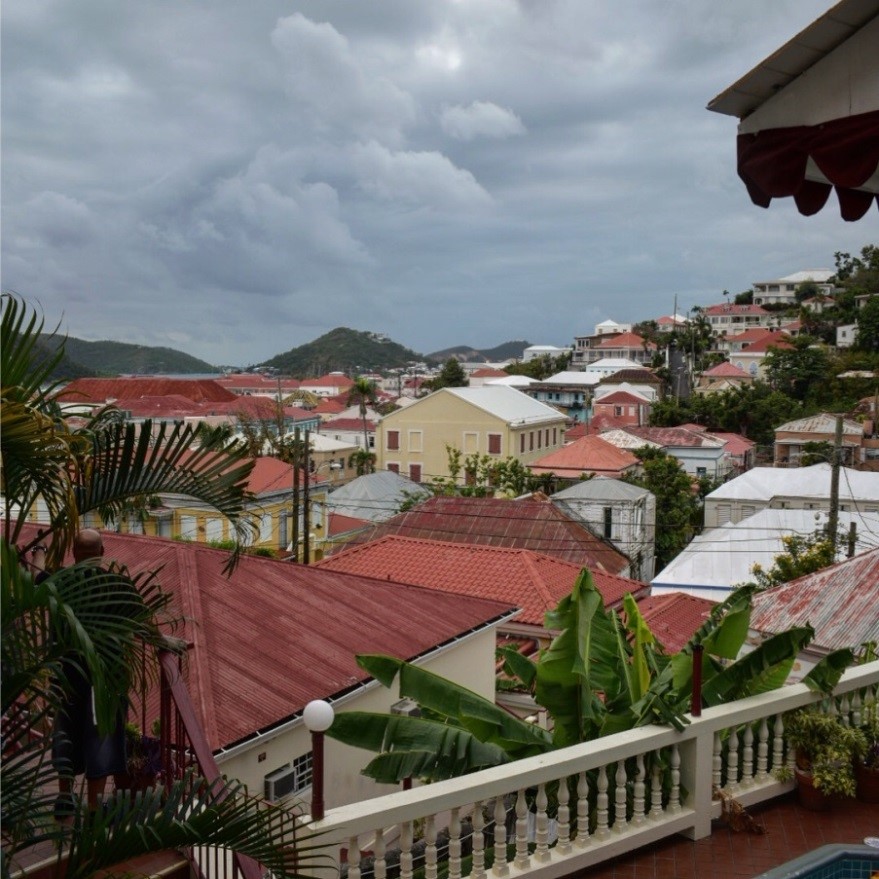
Most volunteers were Americans, but Emil, in the bunk next to mine was a kind Norwegian with a warm smile buried behind his bushy beard. He was one of the first people to greet me and it was impossible not to like Emil. I also became good friends with two English volunteers, Catherine, who we called Lady Catherine because of her London accent, and Ian, a robust, fair-skinned, and very funny guy from Manchester removed from the refinement of London. Ian would be my go-to during my stay.
I immediately judged Lady Catherine as one who wouldn’t get dirty. It was all about her refined accent, this lovely, but snooty-sounding London accent, and I could not have been more wrong. Lady Catherine worked as hard as anyone in our camp, dug right into the filthiest spots, and more than carried her weight in everything she did. She simply kicked ass and made me feel bad that I had pre-judged her worth, by her accent. I should have known better. Living in north Florida, I have many really smart friends, some really smart people with charming Southern accents, who must get judged as badly as I judged Catherine.
All Hands does not pay for your transportation to the island or to the base camp, wherever that may be. I had to secure a roundtrip flight to St. Thomas for the opportunity to volunteer with them. Once on the island, All Hands and Hearts would provide a bunk and three meals a day, except for Sundays. So most expenses were covered and they were very good at explaining what they would and would not provide during my stay.
I first arrived on St. Thomas on a Sunday, the one day off for the All Hands and Hearts volunteers and staff, so I stayed in Charlotte Amalie at a small, partially damaged, but functional hotel called Bunker Hill. Light rain came as soon as I unloaded my pack into the hotel, so I put on my rain jacket, grabbed my camera, and wandered the quiet streets. I always worry most about getting robbed in the early stages of any trip. That’s when I always have the most cash, at the beginning of the trip, and I usually have very little cash at the end. Sometimes nothing. So I took $40 with me to walk the downtown area, left my wallet and bulk of my cash in the room, and kept my camera under my jacket.

Charlotte Amalie is the capital and largest city in the USVI. The downtown area is a city bay where cruise ships dock. There were no cruise ships on the day of my arrival and the town square/market area was vacant. Few people walked the streets and there was little traffic. Cars drove on the left side of the road and the hotel owner warned me to be careful crossing the streets when I did not use to the “wrong-side” drivers. I saw only two functioning traffic lights and wondered why traffic lights would still be down six months after the storms. The town, the buildings, the streets felt battered and worn like they needed a facelift and new paint. I know there had been a crazy amount of work done to get the cruise ship tourist area up and going. A concrete bench facing the bay with words painted, “Virgin Islands, America’s Paradise” was almost illegible because chunks of concrete had been blown loose, I’m sure, by flying storm debris.
The town had moved as quickly as possible to repair the areas near the cruise ships and had their first cruise ship back in harbor by October, a mere month after the hurricanes. The cruise ship travelers with their vacation dollars and call to buy duty-free items were crucial to the economy of the island and it was understandably vital that they were drawn back in. Even now, the governor has stated what great shape the island is in, knowing well that there are hundreds and hundreds of destroyed homes and displaced homeowners throughout the island. Very few cruise ship travelers ever see the inner island, no matter where they dock. And cruise ships could easily move on to a new port on some other island, and leave behind the shop and restaurant owners, diamond store owners, excursion specialists, and street craft vendors to fend for themselves and eventually shut down. Whatever you may think or feel about cruise ships, their presence in St. Thomas stimulates the economy and their absence would be crushing to Charlotte Amalie.
I found a good, but touristy place for dinner, The Green House, and ordered a chicken wrap. A skinny rooster wandered the alley nearby his feathers wet with the light rain. An older black man wandered up to the open window next to my table and asked me for money. I told him I was sorry. “I’m hungry,” he said and turned away. Perhaps, in a nutshell, that moment was the world. A visitor, white and far from impoverished, refusing to give anything at all to a man who was clearly down, but probably spending what money he did get on booze. I drank my beer, enjoyed the dinner, and wondered about the world. I was here to do good things and had just passed on the first opportunity to do so.
The All Hands & Hearts group asked if I wanted to go out on detail first thing Monday morning, but I needed to be at the church by 7:00 am and my Bunker Hill motel was offering a free breakfast, so I opted to wait until noon to check in and see if Charlotte Amalie came alive in the morning. I knew the chances to see the city would be few once I started with All Hands.
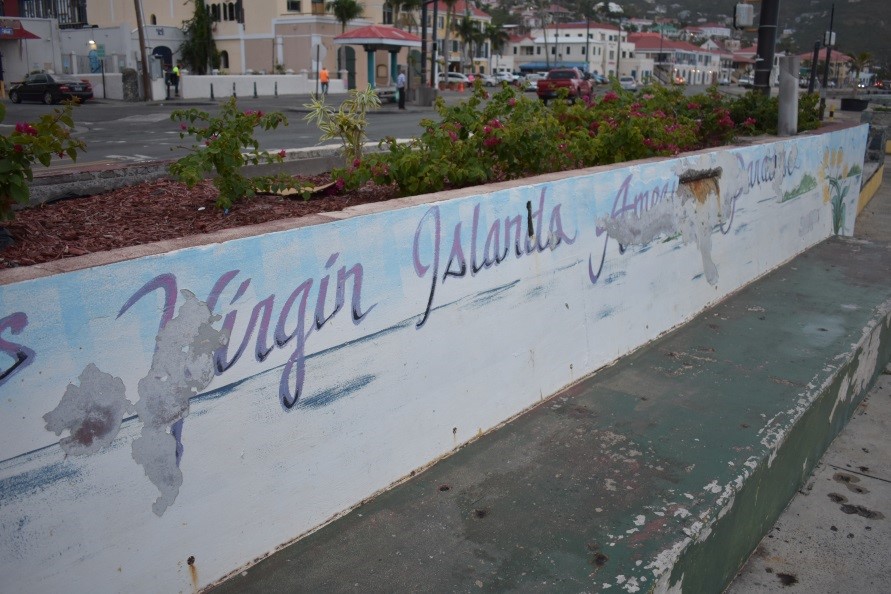
Power went out in the hotel during the night and wasn’t restored until the next day. The staff did a great job of still serving breakfast with gas stove they had relied on during the outages, but only offered a single tiny cup of coffee to me, and did not satisfy the caffeine fiend in me. I wandered Charlotte Amalie seeking my coffee fix and watched as the diamond stores opened on a brick street one block from the harbor. One store after the next, maybe sixty or more, opened their arched doorways to these incredible glittering glass cases displaying row after row of diamonds and jewelry. Every diamond dealer I had ever heard of was on the street and the stores seemed incredibly out-of-place to me. One diamond store had posted its international locations, “Paris, London, Vail, and Charlotte Amalie”. Really? One of my daughters lives in Vail, Colorado and it seemed like the other end of the universe from Charlotte Amalie to me. The entire island of St. Thomas only has 50,000 residents. There is another maybe 50,000 in St. Croix, and 5000 or so on St. John. I am sure the smallish population is why the island has been so ignored in the US press.
The island first became a US property in 1917 when purchased from the Dutch for $25 million dollars. The Dutch needed the cash to fight WWI and I suspect the Rockefeller family was heavily invested in the purchase since their family owns much of St. John and donated most of the island to the National Park service.
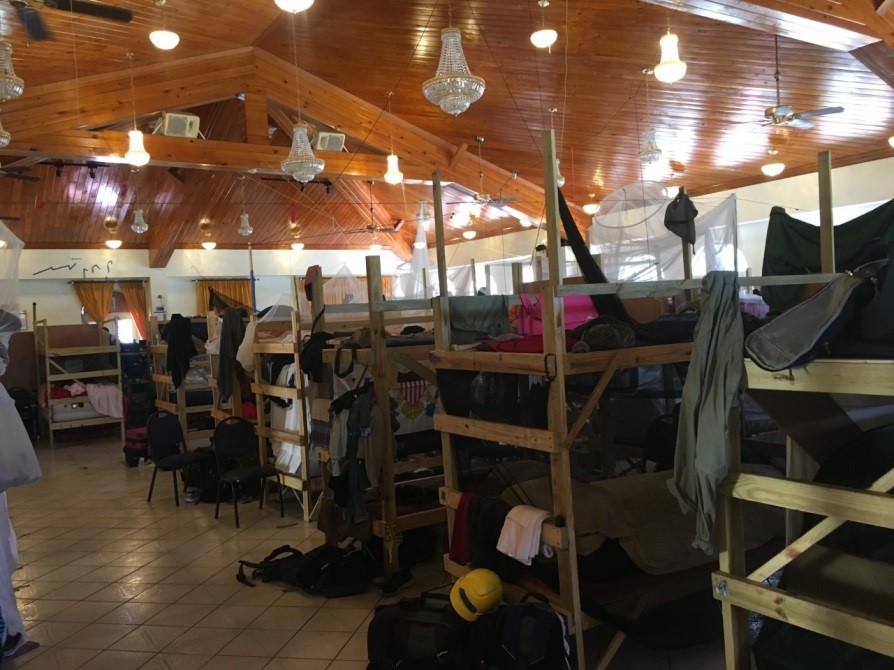
I tired of the downtown and taxied up to the All Hands and Hearts base camp, the Holy Family Church, around noon and was shown around by a skinny white kid named Tobias. Tobias has long black hair and big black-rimmed glasses. His waist must be like a 25” or 27” and his pants barely hung on. I could tell he had walked many people through the same details, “Here’s the lunch fridge, you can have anything in there unless it is labeled for someone. Same with the beer fridge downstairs…And here’s our bunks,” he said, overstating the obvious. The church wedding hall had a beautifully arched wooden ceiling the hanging chandeliers. The entire floor space was filled with bunk beds, most complete with mosquito netting. “It doesn’t look like there are any bottom bunks, but you could have any one of these three upper bunks,” Tobias told me as we walked by the only other person on the floor.
“You can have this bottom bunk, man. I am leaving today,” said this 20-something-year-old guy who I now regarded as a godsend. I mean, I grew up with bunk beds and slept for years on a top bunk. Yes, the last time I slept on a top bunk I was probably 12 years old. It was cool then. Not so much now.
I had shopped for mosquito netting since the All Hands welcome letter recommended it and the fact that Zika was an issue in St. Thomas in 2017, but I never found any netting in Gainesville. If the hurricanes did any good on the island, it may have been that they blew the goddam mosquitoes into the middle of the Atlantic Ocean. I only saw a few mosquitoes over the next three weeks and took my netting down after a few days to improve the airflow in the hot church/bunkroom. There was, of course, no AC. Lots of individual fans and someone had left a little 6” mini-plastic fan unit clipped to the foot of my bed. It generated the smallest breeze possible, but it did help and cooled me enough by 2:00 am each night that I’d need to pull a sheet over me. This would be home for 21 days.
I hate blow-up mattresses. They start out with a nice firm bed and end up feeling like you are trapped in a crevice. Mine lost half its air each night, so I had to blow it up again every day. If I forgot to blow it up before the 9:00 pm lights out, I slept on a near-flat piece of crap Walmart twin mattress feeling the plywood bed frame by morning. I had a blow-up pillow that maintained its air, but it wasn’t great either. My first two nights of sleep would suck, and I was worried about snoring too loudly. Part of the bunkhouse world. My neighbor, Don, older than me, I had been warned, “Snores pretty bad, but with the fans running, it all kinda blends,” said the young man that had offered me his bunk. “Good to know,” I offered, comforted by the fact that I wouldn’t be the only snorer.
During my orientation with Tobias, I met Steve, early 50’s, short-cropped hair, former military. He had asked me to check in with him when I arrived, but I had to do my full Tobias tour first. I found Steve later, at the staff table area, a raised platform area that was probably set up for the choir when the church was happening in the building. Steve had looked over my application, knew that I had construction experience, read that I was a home inspector, and wanted me on his “Rebuild” team, a small group that did not have to deal with “muck and gut” clean up. He invited me to go to the local hardware store to order T1-11 plywood panels for the interior walls at a local school that had flooded. At the school, the inside lowest 4’ of sheetrock walls had been soaked and were covered with mold. The “muck and gut” crew had already completely removed the lower 4’ of sheetrock at the walls. Rather than reinstall sheetrock, a decision had been made to replace the sheetrock with T1-11 exterior grade plywood. It could be removed by backing out screws if it got flooded again, and could potentially be reused if disinfected. Sheetrock, other the other hand, every time it got flooded, would need to be trashed.
MSI, the local hardware store, had materials, but not everything. Steve’s order for 133 sheets of plywood would be over $9200, with the AHAH discount of maybe 5%. About $70 per 4’ x 8’ sheet. About two and a half times as much as it would cost in the US. Geez. And All Hands would foot the entire bill. They muck and gutted, would pay for materials, and would install the new plywood. It was a big job, but it was a school and critical to get the building back to operational status. No child should miss out on a school and every child should be able to go to a school safe from mold and other airborne hazards. It was a totally worthy project.
The AHAH teams began to stream back into camp at 4:00. They wore yellow hard hats and were dirty, mostly young millennials, about 70% male, going about their business of cleaning up and stowing their tools to be ready for the next day. The mood was light with lots of warm smiles. A blue plastic tarp was laid out in the tool room, the lower work floor of the church, and was covered with boots. The attempt was to keep any contaminated mold of nastiness out of the living eating quarters upstairs. I’d wonder later, “What about these horrible pants I am wearing that were doused with 6-month old ooze from a closed fridge and stink so badly that they make me want to gag?” Well, those pants would stay in a stinky pile by my bed all night and get worn again the next day.

Volunteers were pretty welcoming. Especially the younger crowd. A few of the older guys just looked too tired to play friendly. That’s when I first met Emil from Norway, who looked like Jesus Christ. “Welcome, man,” he said.
“Thanks,” I offered.
“You are from?”
“American, from Florida,” I answered.
“It’s good,” he smiled, “Glad you are here,” and he headed to the shower. There was a single shower on each floor for men and one on each floor for women. Navy showers, where you turn on the water to get wet, then turn off the shower to suds up, then rinse as required. Water was scarce and if the cistern ran low, All Hands would have to purchase shower water and freshwater was expensive. We also kept buckets under the bathroom sinks to catch water for flushing. It was a pretty good system.
Dinners were prepared for us by an islander named Mekia. She had beautiful smooth caramel-colored skin and twelve children. Twelve. Each night, except for Sunday, she would prepare enough food to feed 50-80 AHAH volunteers. Her main go-to was chicken and rice and she would make a sample plate to show us how much food we should put on our plate so there would be enough for everybody. Usually, two chicken legs and about a cup of rice served with a spicy creole-like sauce. She also prepared a separate menu item for the vegetarians in the group every night.
If everyone got a plate and there was food leftover, an announcement was made and anyone who wanted seconds could get in line. Most nights I was so hungry that I could have eaten anything and not complained, and I did go back through the second’s line a few times. Good Morning America did a piece on Mekia and her family while I was down there. I was not in the 4-minute video, but I knew all the volunteers seen in the background.
When finished with dinner, we washed our own plates and utensils in a soapy wash, then a rinse, and then into a bleach-soak for ten minutes. It was all very efficient and a little military-like, or maybe 7th-grade camp-like. From that point, there was an hour, hour, and a half for private time, phone time, cards, reading, or whatever. I was usually lying atop my crappy Walmart blow-up mattress by 9:00 for lights out. Or I escaped to my hammock that I had secured on the church balcony. My hammock was open to the first user though, so I only got modest use out of my own hammock.
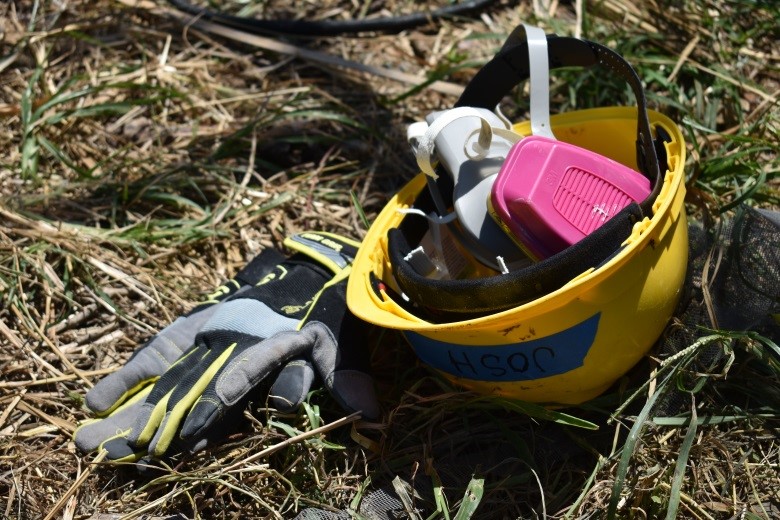
My first day officially on the job was at a home that was ridiculously difficult to access. In fact, the home was so damaged and the driveway/road access so blocked that other organizations had said, “Sorry, we can’t even access this place” and had just left. All Hands had apparently been there for over a week and had hauled out over nine 20-yard trash containers full of debris and funky trash from the property. The homeowner named Melbert was not present but had a three-level home built into the hillside. The view was incredible, facing north and offering a beautiful view of the turquoise Caribbean Sea maybe 500 yards below us. An Atlantic Nor’easter was blowing giant waves into the cove way below Melbert’s home…well, former home the day I was there. I estimated waves to be 12-14’ high with thick walls of whitewater that splashed off rocks to jet 30” high. Not your typical St. Thomas wave action. I was amazed at the power of the waves even from such a distance. There was no access to the beach that I could see and definitely no path from Melbert’s home down to the sea. But the view was spectacular.
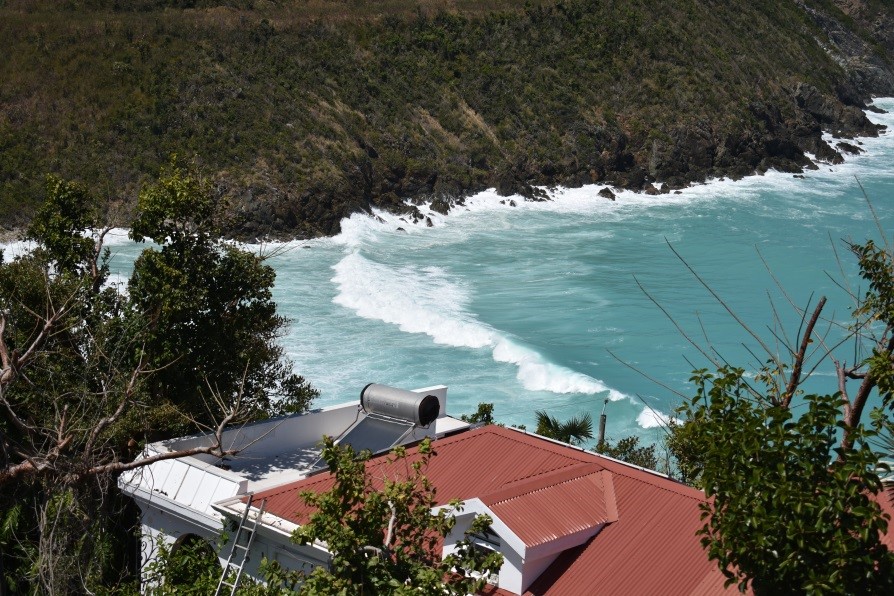
As our group did morning stretches and in turn, introductions, I felt more part of the team. We were not going to just dive right in and work, but have a solid plan and our TL (team leader), Rob, from Washington state, a member of AmeriCorps, and a quiet badass would lead us through safe and sound practices dealing with the site. Melbert’s site was a mess. The top two floors of his home had been blown into the Atlantic or landed in a swimming pool that had been on the second floor. All Hands had been there a full week and cleaned so much debris that the site was now fully accessible and the pool was mostly cleared.
There was still a foot of water and nasty muck debris in the pool. The sewage-like odor triggered a gag reflex in me and I tightened my respirator straps. Our TL, Rob suited up in full Tyvek, legs in black garbage bags duct-taped to cover his boots and he waded into the mess. He would spend about two hours shoveling the nasty out of the pool, hoping a nail didn’t puncture his boots, and we would pass the foul debris bucket by bucket to the next person, up out of the pool and then down steps to into the dump container. Two Millenials, Zak from San Diego shaved at both sides of his head with a high ponytail, and Maddie, a young volunteer with a huge smile took positions 2 and 3 down in the shallow end of the pool to lift the funky debris out to me. I handed off to Pamela, a lawyer from Brooklyn, who handed off to Marty from Pennsylvania, who handed the buckets to Davone from not-sure-where. I kept offering Maddie or Zak to switch positions, but they hung in there the whole time down in “the pit”. So did Rob. When we had the pool cleared, maybe 10:30 in the morning, Rob un-suited, and his clothes beneath the Tyvek suit were completely drenched with sweat. Completely drenched. No one was happier than Rob to have that portion of the job site cleared.
AmeriCorps was started in 1993 under Bill Clinton’s direction and employs about 75,000 Americans in service each year. It has been compared to a domestic Peace Corps. Those involved may receive meager payment or be working off student loans. There were about ten AmeriCorps volunteers working with All Hands when I arrived, most of which had been there over three months, and they kicked ass working. Rob was no exception. A leader and an incredibly hard worker. It was my first workday and I was glad to have solid leadership.
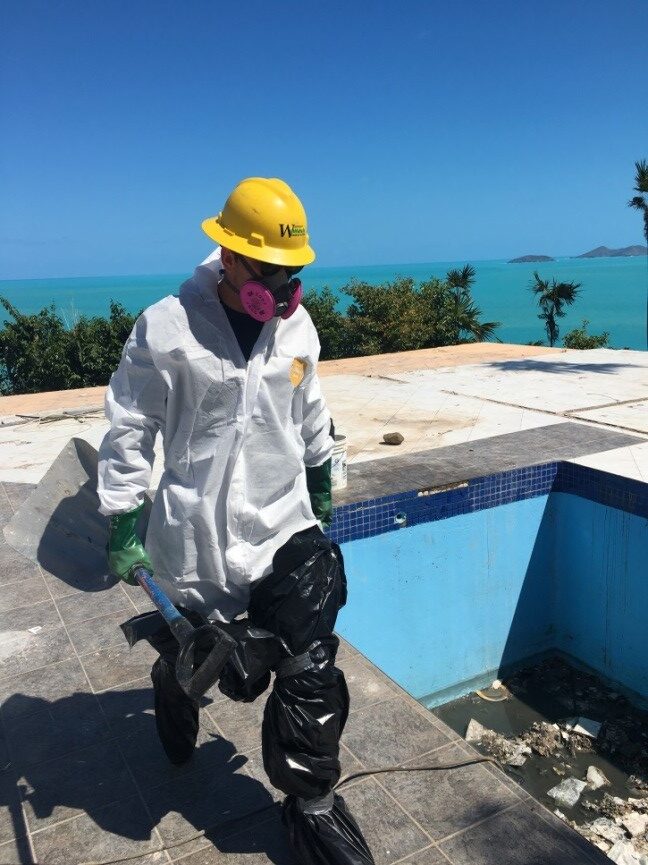
We cleaned the last of the pool debris and then turned our attention to the lower apartment. Nearly all homes on the island are built into hillsides because the entire island is hills. Often the lower apartment might be rented or used by other family members. The lower apartments were more bunker-like and many lower apartments survived the storms much better than the upper floors that were often decimated. Like Melbert’s home. The upper two floors were gone. Stripped down to the concrete slab. Debris was strewn everywhere and All Hands had collected the debris and moved it off the property. The lower apartment was basically intact, but had been soaked through and was full of really nasty 6-month old mold, loose flooring, and needed a full muck and gut. All furniture, clothing, and appliances were ruined, but we searched through the site and collected anything that might have sentimental value and might be salvaged for the owner. There was very little that we could save. A wooden dresser came apart in my hands as I tried to move it and a rat skittered out from the rotten base. A small woman volunteer named Nah nearly jumped out of the open window when she saw the frightened rat. Three more rats followed and each scurried the edges of the walls looking for a hiding place.

We muck and gutted the apartment in about 4 hours, dragged out furniture that came apart in our hands, managed foul mattresses that we tried to keep at arms-length, and scraped up loose vinyl floor tiles with shovels. We worked with P-100 respirators, sweat from my face dripping inside the mask, and transformed the two bedrooms and tiny kitchen and bathroom into relatively clean empty space in just a few hours. An old spiritless hound dog watched us work. He was chained to a front porch post. I don’t know if I have ever met a dog with less spirit than this old guy and he pulled at every volunteer’s heartstrings. We found flea medicine in the piles of debris and applied it to his back. He was covered with fleas and he didn’t even seem to care. The crew had also brought canned dog food with them from the church camp and left it in the apartment window. Pamela, the lawyer from Brooklyn, took it the hardest. She was a huge dog lover and wanted to bring the hound home to New York. I wanted to tell her that there are dogs to save everywhere, but you could see how hurt she was by the dog’s lack of any spirit. Dogs have a different place on the island than they do back on the Mainland. Most are skittish and clearly don’t trust humans. Most never wag their tails. And in three weeks I never saw a dog being walked with a leash. I know American dogs are spoiled, but dogs in the USVI just do not hold a very high place on the ladder of importance.
On an assessment assignment a few days later, I met two pups, 7-8 months old who were happily wagging their tails and greeted me by rolling on the backs so I could scratch their bellies. They were not chained or fenced in. Their owner was a gregarious island woman with a loud laugh and 1970’s afro hair that must have been a wig. Her home was totally uninhabitable. We were assessing it for the AHAH queue. She had simply taken her children and left the island for four months after Irma. She had nowhere to stay in St. Thomas. And she had left the dogs, then about 8 weeks old to fend for themselves. Not a mean-spirited thing, just a priority deal. The pups were siblings and apparently fared quite well on the island by themselves. They both appeared to be healthy, no rib bones showing, and they were the happiest dogs that I would meet on the island. “There were only this big when Irma came,” the owner said holding her hands close together, “and when we came back they were all grown up!”
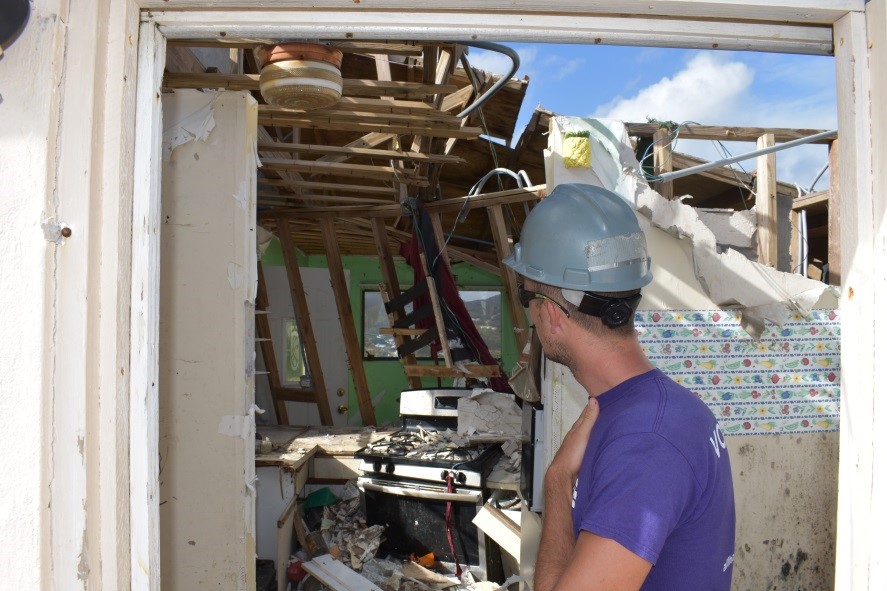
Because of my construction and home inspection experience, I would get moved from work assignment to work assignment. Many of the volunteers got assigned muck and gut after muck and gut. I had the opportunity to work on the roof at the pre-school Little Blossoms, go on home assessments with Amie, the lead assessor, do roof assessments with Max, who was in charge of starting up a roof rebuild sub-group at AHAH. My favorite assignment, though, was as an assistant TL in charge of dismantling a hazardous roof system so our team could get in and muck and gut a home for a beautiful couple named Jenny and Artnell. Our TL was a 30-something-year-old guy named Duncan, from Montana. Duncan was one of four park rangers volunteering with All Hands who worked in Glacier National Park, arguably the most beautiful park in the USA.

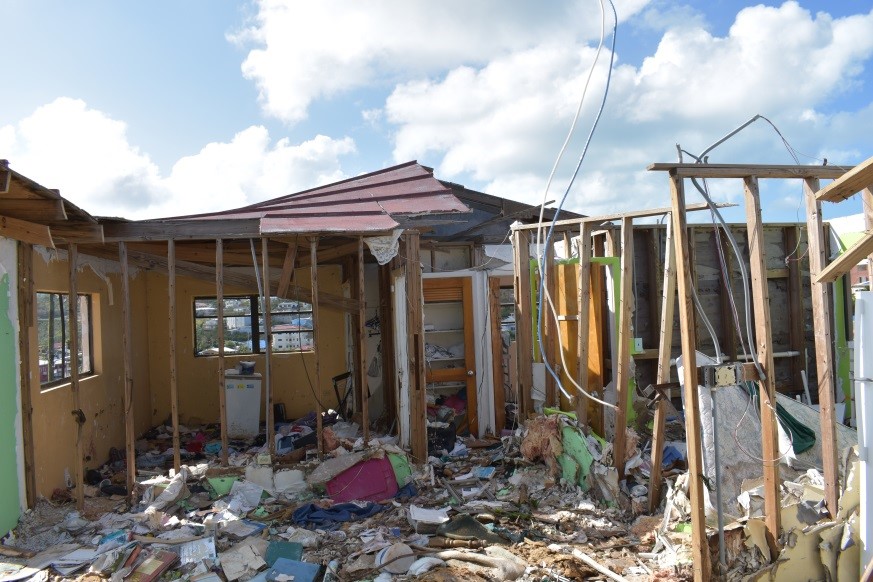

Duncan had been ATL with another Glacier guy as TL named Monk. Monk and Duncan. It was just fun to say aloud, “Monk & Duncan” like it should be an ice cream store or something. I loved working with Duncan. He was soft-spoken, nice to everybody, and hard working. We showed up at Jenny and Artnell’s and there was already an empty dumpster outside ready to be filled. Duncan peeked in the front door and we could see the entire roof system had collapsed or was just gone. Broken trusses with nails and screws sticking out hung over what had been the living room. The outside block perimeter was still intact. Interior frame walls were mostly crushed or leaning. Jenny and Artnell had spent four hours trapped in the kitchen during Irma with a wall leaning toward them and no more than about 6 feet of space to ride out the storm. Irma had destroyed their home and trapped them in that tiny space. Hours later, Jenny’s brother would come and wrench the kitchen door open so they could get out. Artnell told us the story during one of our lunch breaks, as he had many times in his church. He said every time he told the story, it made him feel better, like the storms and the near-death experience were a little further away. Artnell laughed and told of cooking BBQ for his family and friends and playing dominoes on his patio. He was all smiles and brought us lunch and cold drinks the first day on the job.
Artnell was a chef and had retired to work from home. He had stints in his heart that prevented him from doing any heavy lifting and he told us over and over how grateful he was to have us cleaning out his home. Artnell’s home was not built on the hillside, but rather on the hilltop, with a distant view of the sea. The roof system was incredibly strong with metal straps wrapping up and over each roof truss and anchored with ½” thick steel bolts through a 2” x 8” perimeter boards and directly into the exterior block wall. The straps were over a foot long at each side of the truss, much stronger than anything I have seen used in mainland construction, and they were sheered and/or ripped completely off most of the walls. The portions of the roof that remained were just a hazard. Nothing salvageable. Our first job would be to brace overhead hazards, then cut and remove those dangling hazards, and then we could get our full crew inside safely for the muck and gut.
We had a crew of seven and I felt like we did the work often. Lady Catherine worked so hard in the sun, I thought she may have had heat exhaustion at the end of the day. She worked relentlessly. A new arrival volunteer named Alfonso joined us on Day 2 at Artnell and Jenny’s house. He was small in stature but strong and capable. The question in our stretch circle was, “Why are you here?” and Alfonso said, “Many people back home asked me why not help at home in Columbia? There are many people in need. But I want people to understand that we Columbians can also help around the world.” And Alfonso was a huge help and unselfish about any assignment. He loved Pearl Jam and played their music at night on the balcony while I wrote in the nearby hammock.
It took us three days to complete the full cleanout and roof removal at Artnell’s (three photos at right). I loved that crew and felt like we moved the world forward for Jenny and Artnell. It felt very consistent with homeowners that I met, that the task at hand was impossible at first sight, that there was no light at the end of the tunnel, just a soggy, moldy, well-destroyed former life. But once we came through and did a thorough muck and gut, the light began to show through what had been a long dark cloud. I could even see their pain in the physical stature. Homeowners would physically slump at the shoulders when I met them with Amie on assessments. I commented that most of the homeowners seemed to be slumped over physically, just didn’t stand up straight. The weight of the world? But when we’d clear out a home that looked like it could never be cleaned again, their posture improved, their smiles returned, and their gracious thank yous were incredibly nice to hear.
I loved meeting the volunteers. Energy is the intangible vital connection that I feel in others. It can be as simple as a smile from a cashier at a convenience store, to a “Have a great day!” from a hiker, a kind, “Bless you,” from an elderly woman on the bus, but the energy is clear and good. The transfer of energy from one with good intentions to a like-minded person is easy to feel and builds like a wave in the sea. Rhythmic, cosmic goodwill toward the universe. I felt it all the time with the All Hands volunteers and tried to project the same kind of positive energy into everything I did. It was hot, sweaty, and totally exhausting work that could be insanely joyous.
Islanders knew about All Hands and Hearts, but almost nobody got the name right. We were the “Purple shirts” who got stuff done. We were Helping Hands. Angel Hearts. Heartful Hands. Any number of odd combinations, but we were easily recognized by our purple shirts. And welcome to the community. I was already a part of the community once I donned the purple shirt because of volunteers before me.
Once we completed Jenny and Artnell’s home, Duncan and I got moved to the aptly named “mountain goat project”. The TL was Monk, who made up the Monk & Duncan. A super nice guy and one of the groups of four volunteers that work summers for Glacier NP. They are an awesome group. All friendly, all chill, and they work really hard and laugh a lot.
When we got dropped off at the MGP, we couldn’t even see the home from the car. Duncan and I got out and walked to the edge of the street and looked down the steep hillside to see a pile of rubble with a single standing wall that looks like it used to be the bathroom, or maybe the kitchen (right photo). The interior used to be metal frame and the framing was now twisted, bent, and half covered with concrete, sheetrock, appliances, furniture pieces, and wood. It looked like something you’d see on the evening news, like a bombed home in Syria. It literally looked like a bomb was dropped on the home. And the pile of rubble was 33 steps below us. All that rubble would need to be brought up to the road and lifted into 20-yard garbage containers, bucket by bucket, piece by piece, up 33 steps. It made my legs ache to think of it. Our last home was an equal disaster and had a hazardous partial roof, but it was basically a hilltop house with only 4 steps into the front door. This MGP was a whole different beast and it looked impossible.

Duncan and I jumped into the muck and gut fray and in a simple three trips up sharing the weight of a half-loaded garbage can of trash, I was shot. I needed water. My legs were trembling. Damn. I told Monk I would only be able to do maybe three trips and then I’d need to switch to a different task, catch my breath, and then be ready to go three more. He was in full agreement.
Scott, who I’d worked with on the preschool roof, was climbing the steps without breaking a sweat. That shit did not seem fair. But Scott is an animal. I knew he had hiked the full length of both the PCT and the CDT and probably would have left me miles behind the first day if I had hiked with him. And I am a capable hiker. But not like Scott. During my stay, he secured a job back to the US to work in the Smoky Mountain National Park. He looked at me at the top of the steps, taking a break before I could heave the trash into the bin.

“You need to be careful,” he said. Yeah, right.
As the day wore on, it only got hotter. We fire-lined some of the debris, handing it one person to the next up the steps, which offered a break from climbing the steps, and then carried buckets of rubble back up, one 40-lb bucket in each hand, me talking to myself out loud, “I am not gonna let these steps kick my ass”. And I drank lots of water and never peed.
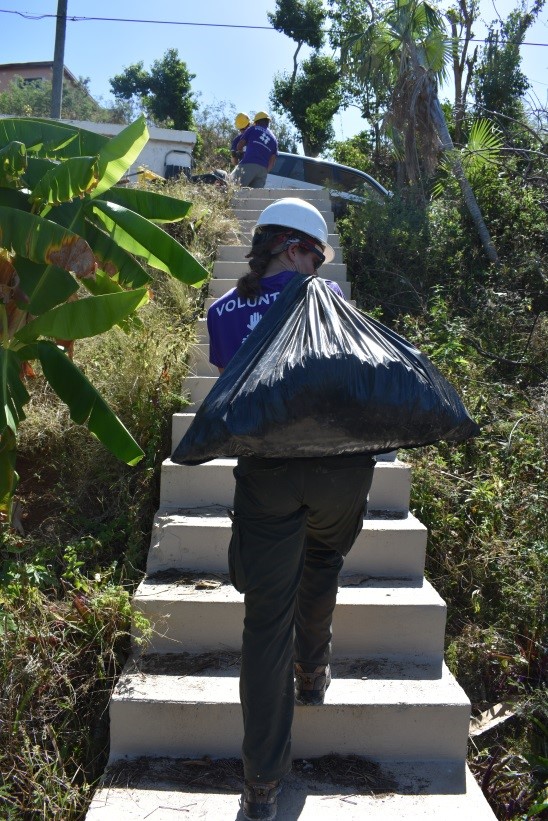
I do know better than to push too hard. I also know how much I want to carry my weight with this group. Duncan said several times how this was the “A-Team”. Mostly guides and park workers, all fit and strong. And then me. I was trying to hang and was getting excellent cardio. But mindful that too much cardio for a 59-year old might be a problem. My legs felt every step like doing stadiums at the University of Florida. 90 steps there and only 33 here. But I do not do stadiums at UF carrying buckets of broken concrete.
One of the four Glacier National Park workers is a young woman named Andrea. Very attractive, with strong facial features, high cheekbones, and a firm chin. A perfect smile and beautiful, but not girly at all. Strong. Kickass strong. When we were loading up water in the morning, Monk was struggling to tear the plastic cap off a 5-gallon water jug. He asked for help and another guy tried, but couldn’t budge the cap. Andrea ripped it right off. Like I said…strong. Really strong. Way stronger than me. Stronger than most of the men here. And she works without any complaints.
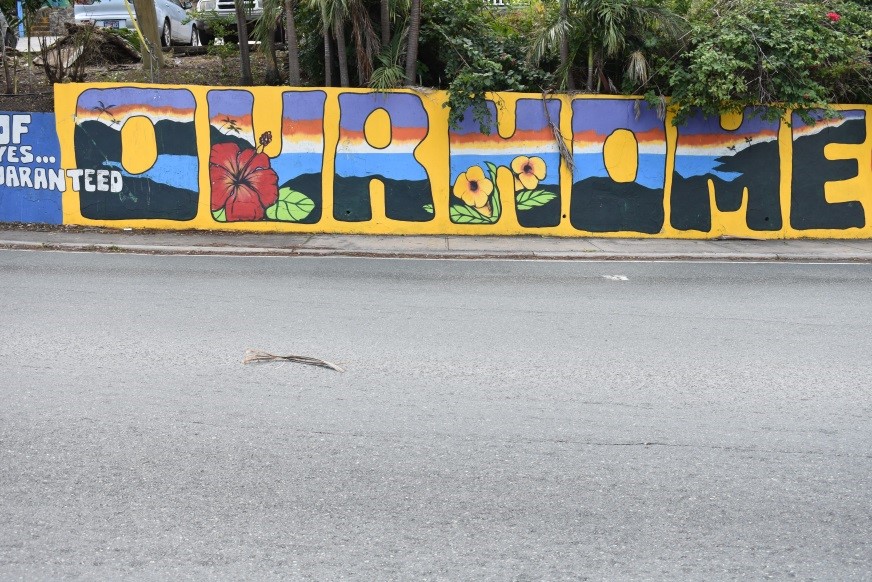
We worked hard through the afternoon. My shirt was soaked with sweat. My pants were soaked from the waist to halfway to my knees. I told Andrea, “I will be cramping in my legs tonight”. And I was so right on. Large quad muscles at the back of each leg took turns placing me in near agony for about five minutes each. Both were only 75% cramps. I knew if I even twitched or tried to straighten my legs, the cramps might go 100%. I lay in my bed and waited, agonizing, but waited. One leg, then ten minutes later, the other. No pickle juice to treat to cramps like I would at home. Used to be I’d only get cramps in my calves and they were reachable and could be massaged out. The hamstring cramps are ten times as painful and last longer. Old age sucks.
I also had a chance to learn about Assessments and got to ride along with the lead Assessor, Amie, and one of the younger volunteers, Lucky, who had never been known as “Lucky” until she arrived on St. Thomas. Lucky had apparently played roulette on one of the cruise ships when she first arrived on St. Thomas and hit numbers at a roulette table three spins in a row, winning a bunch of money and getting stuck with the name Lucky. I didn’t even know her real name. Lucky was early 20’s, Amie appeared to be early 30’s, and old guy Josh would ride along in the back seat, observing, asking questions, and taking photos at each home assessment with the homeowner’s permission.
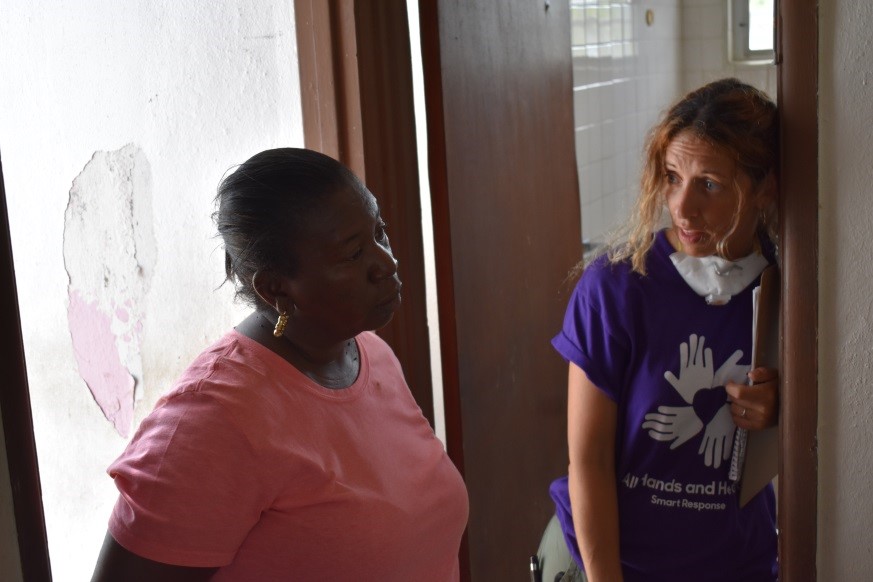
Amie is a whirlwind with a mop of curly brown/blonde hair with streaks of purple. Her hair is an orderly mess, a perfect oxymoron, that may describe the person. She is all about getting the job done, but fits into this insanely patient “island style” pace and looks like she would be as comfortable dancing at a desert music festival as speaking before legislators at a state meeting. She is fit and tan from her time in the Caribbean and someone I would get to learn from. Amie had established a vital position in AHAH, being the first contact with homeowners in need and was tasked with the job of inspecting homes and establishing a spot in our queue determined by a number of factors.
Lucky was nearing the end of her three-month stay with AHAH and had never gotten to do assessments. She was one of the world travelers and was very confident at her young age.
Assessments had to go through the phone or email loop first at the office, then homes that were considered candidates for All Hands were checked in person by the Assessor or Assessment team of two. A hefty list of considerations, like whether anyone was living in the home? Were there children or elderly people there? Was the home safe? Was it a primary residence? Did they have insurance? Were the owners First Responders? and a number of other things. Are you poor or wealthy? was not a criterion. But the list of pertinent questions established a hierarchy and higher scores moved toward the front of the queue. After assessing my fourth home, I was pretty good at guessing where the score would fall compared to the other homes.
What Amie brought into the home was humility and an understanding that these homeowners had had their lives flipped upside down, quite literally as well as figuratively. She was gracious with every person we met and knew how to nudge the conversation forward at all times, even when the homeowner had tears in their eyes. We met with one woman who showed us her damaged home. There was still sheetrock barely hanging from her kitchen ceiling that was solidly black from mold and looked like it could fall at the slightest breeze. Most of the roof was gone. Lots of muck and gut were needed and the home was uninhabitable. She walked us downstairs to assess the lower apartment which was intact but had lots of mold and water damage. There was an undamaged photograph on the couch, set in a large frame. A lovely girl that looked maybe 17 or 18 years old, in her prom outfit, complete with a tiara. Amie picked up the photograph, “Who’s this?” she asked.
“That’s my daughter. She passed away last year before the storms,” said the mother and she looked straight at me, knowing I was the other person in the room old enough to be a father and might best understand her pain. Not only was I a father, but I had three daughters and the thought of losing any one of them was unbearable to imagine. I looked at her and tried really hard not to cry, but felt this tremendous sadness for her. We both allowed the connection. The storms were just a hard slap in the face after losing her child. At what point do you feel like the world is not fair at all and question whether God is there at all. This was a kind, gentlewoman, it was easy to see. No malevolence in her at all. But like the dog that was chained up at Melbert’s house, her spirit had been irreparably damaged.
“It is hard,” she said and her voice trailed off.
“I am so sorry for your loss,” was all I could say and I gave her a hug, not knowing if it was the right thing to do or not. Human connections are usually compicated and take time. As a father of three healthy daughters I felt emotionally crushed for her.
“I just go to work,” the homeowner told us.
“What else do you like? What do you do for fun?” Amie asked moving the subject.
“I used to dance, but I am too old,”
“Never too old to dance!” Amie told her and they talked about music and dancing all the way out of the home and back to our car. Amie laughed with the homeowner and worked to bring her forward. It was pretty hard for me to be objective and I would have wanted to bring her to the top of the queue for repairs to show her we were committed to helping her life brighten after the worst year imaginable.
Amie and Lucky were in charge of the Assessment, but I was the person closest to the mother’s age. She was an islander with dark skin. I was a Mainlander with light skin, but we have the same hearts. We bleed red. We have the same love and we pain over the same heartaches. I hope I never have to go through heartache like this lovely woman was suffering through and if our eye contact, our moment, the All Hands and Hearts earnest effort to help make any difference, then I hope it does for this mother who had lost so much. Life is not fair, but there should be a limit to how much heartache should be shoveled out to decent folks.
We inspected four homes that morning. One home belonged to a tall, slender man named George, who invited us into his damaged home. A wind chime hung in the front door, “Welcome to our little oasis”. George and his son, George, Jr. known as Junie, were trying to make space and clean things up, but the home needed a solid muck and gut. The steel roof beams had survived the storms, but the metal roof leaked and most of the windows had been blown out. George Sr. was quiet and so gentle. We gave him a dust mask so he wouldn’t breathe in the moldy air. He was 82 years old. As Amie inspected the moldy kitchen cabinets and spoke with Junie about anything he would want to save, I spoke with George Sr. about the storms.
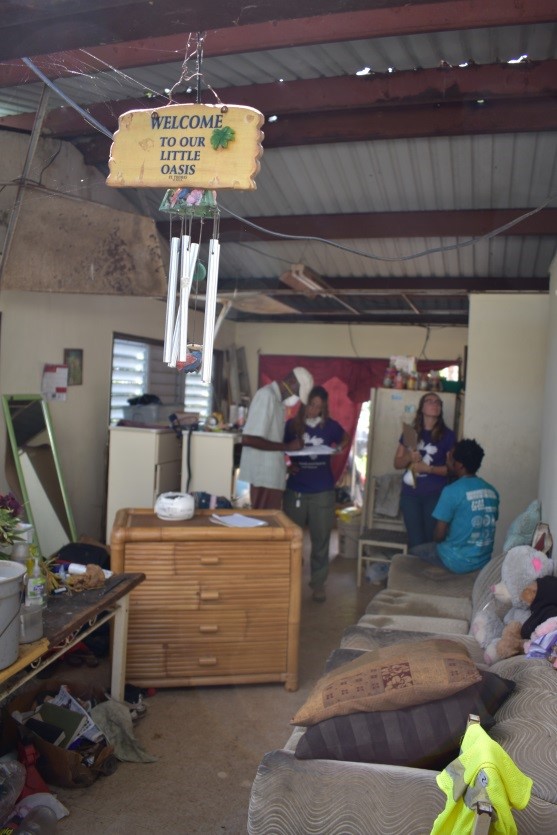
“I was in there, in that closet during Irma,” he told me in a quiet voice, pointing to a bedroom closet. Both the windows were boarded up with plywood so it was clear that the windows had been blown out.
“I went to check on my son and had to hold onto the door frame,” he told me turning his hands sideways, “ because the windows in this room got blown out.” This quiet man with a calm voice and watery eyes told me about the event like it had just happened. I did not want him to relive it and only hoped that by telling the story would maybe ease the burden. Maybe. I tried to but could not imagine what those days/nights must have been like. My heart went out to him, I snapped photos of his home, of his destruction, and wanted to find words of comfort.
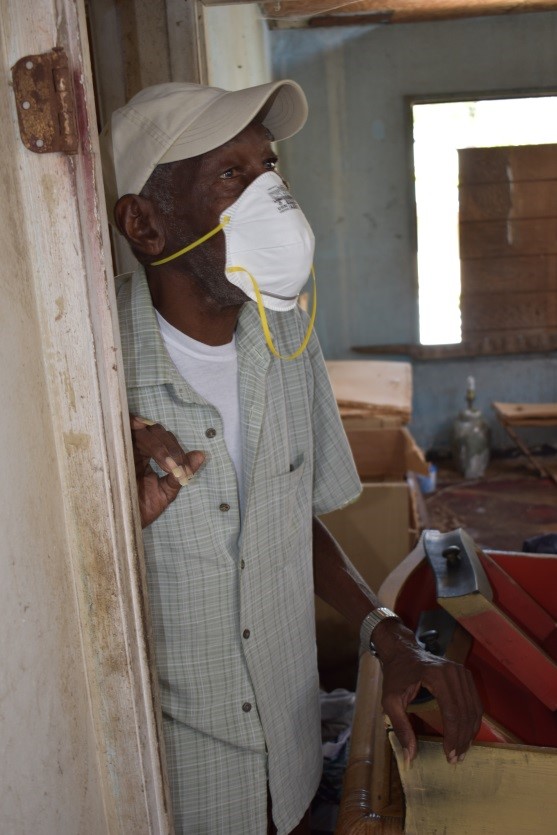
“I hope we can help,” I told him and was later told by Amie to be careful not to make promises we couldn’t keep. I didn’t know enough about Assessments to know why George and Junie wouldn’t go right to the top of the queue for our type of work. Amie was the one with the right words and at the end of the day I was drawn to one statement she had made during our Assessments, “Thank you for the privilege of coming into your home.”
It seems that the greatest kindness we can bestow on others is to, as Harper Lee teaches us in “To Kill a Mockingbird”, try to walk around in their shoes for a moment. I watched, I listened, I tried to tune into that vibe. A message of love. To people that had been through Hell.
Most of the fatalities in the islands were from glass shards being blown through homes. How would anyone be able to treat a serious glass cut when there was no way to leave the home, maybe for many hours, and then even if they could leave their home for help, where would they go? I thought about how vital it would be to have first aid supplies and some knowledge of how to use them if you lived on one of the hurricane-prone islands. It could make the difference between living or bleeding out.
One of the worst things that George Sr. told me was that he had been mugged two nights earlier by three hoodlums in the neighborhood. They took $5 and a pistol from him. I suspect they somehow got word that 82-year old George Sr. had a pistol, or maybe they were just punks targeting an easy, old mark. He had me feel the knots they left on his head. As much good and heart-felt positive energy as I was experiencing through the volunteers and homeowners, it is clear that natural disasters bring out the very best and very worst in people. Maybe it is as simple as William Golding’s, “Lord of the Flies”, that people are inherently Good or Evil, or maybe it is without one the other would not exist. My anger toward the punks that would beat a kind old gentleman like George was tempered by the softness of his voice and his ability to let it go.
My first year doing home inspections, I inspected a very messy home, owned by a smallish, elderly man. I had made a few comments to the potential buyer about problems with the home, and I noticed how stupid I was to be in another person’s home, not a house, his home, and then be critical of something he loved and had taken great pride in. Even if it was a mess, even if it needed work. It was his home. I realized that I needed to always be respectful of another person’s home and that I was the guest, regardless of the work I was doing. It was a lesson that stuck with me for the next 20 years of home inspection work, and a lesson I did not need to re-learn in St. Thomas.
Amie, Lucky, and I talked about the Assessment experience. There wasn’t much time for anything but a snack on the drive, a sip of water, and deciphering directions about landmarks and turns on streets with no names delivered to us in strong dialects, but English nonetheless. I had to focus hard to understand the voices I could hear from Amie’s speaker phone. I was in the backseat, along for the ride, and trying to take in everything.
I want to be able to manage my real life and do this kind of hurricane relief work at the same time. I am always concerned about how many strong viable, giving years I have left. How much longer will I be strong enough to handle this kind of work load on any sustained basis? How come I started so late? How much difference could I make? This group made me feel like I was making a difference, much more so than I thought when I arrived at this island a few days earlier.
Our last assessment of the day was with a sweet woman who showed us her damaged home and walked us to the back bathroom where her family had weathered the storm in the master shower with mattresses stacked up beside and above the shower to create a bunker, and the bunker had held and had remained exactly the same 6 months later. She was lucky. I met homeowners later in my stay who watched their bed sail into the ocean like a magic carpet ride. And no one in her family was hurt.

Assessments proved to me to be exhausting. A woman whose teenage daughter had died of an illness prior to two gigantic Atlantic hurricanes trashing her mother’s house. An elderly man, trying to regain his home for himself and his son, who had been mugged and just wanted to get his home back. Homes that were still in horrible condition, six months after the storms, filled with toxic mold and damaged memories. Photographs and photo albums, wedding albums, soaked through and useless, laying on the floor. The stories, the people took their toll on me. I felt more tired than if I had done tough physical labor for twelve hours. I was just plain spent. I guess Amie could tell as I sat quietly in the backseat. She and Lucky dropped me off at a muck and gut site to finish the last few hours of my day. The labor was a relief from the Assessments, but I felt like I’d been given a gift of greater understanding of the toll disasters take, even long after the initial damage is done.
Amie talked about the studies she had read regarding the human capacity to retain hope. That there is a finite time that we can process and maintain Hope, and often about six months after a major disaster, those who have not recovered or do not feel there is Hope in their situation, can actually die from the experience. I began to have a better understanding of that crazy dynamic and see in the body language, in the conversations, that some of these islanders had been suffering for a long time and needed something positive to happen.
I was assigned to a muck and gut home the next day. Each evening the staff would fill out a dry erase board with the teams and list how many volunteers would go to each site and list the team leader and assistant team leader for each group. I got switched around from group to group most days and had enjoyed meeting new volunteers and having a chance to meet with new people. Our new assignment was close to our church camp.
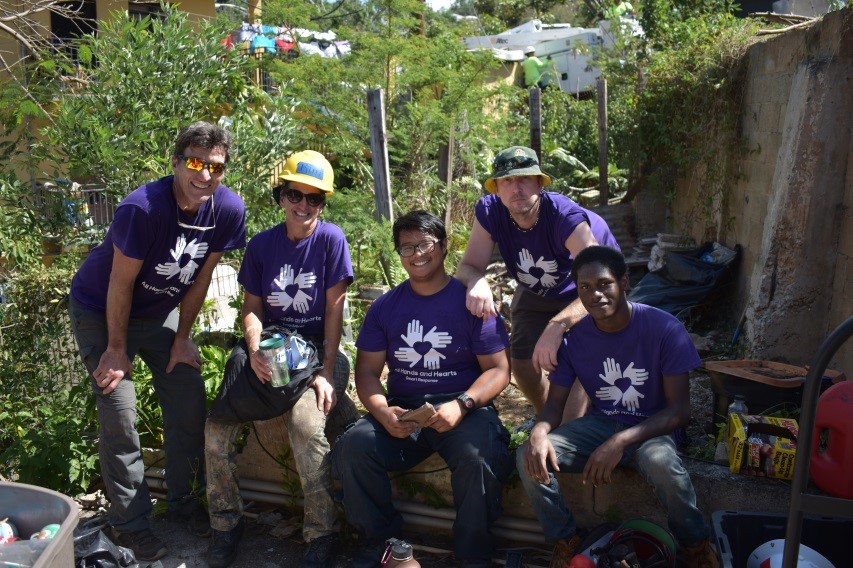
Jason, the TL, is a thick Marine who has lost 30 lbs. here volunteering the last two months. He is Ecuadorian descent, but all-American and likes to lift heavy stuff. I had seen him several times after our workday beating an old truck tire with a sledgehammer, or flipping the tire over and over in the church parking lot. Extra workout, when the rest of us were spent and done for the day. Unlike the first day when our TL, Rob, took water breaks all the time, I had to call for a water break with Jason. He was super excited that we were doing so much so fast and our crew was awesome. Jason lifted two logs up onto his shoulders, instead of a manageable one, got them balanced, and headed up the stairs to the drop site. As I said, Jason loved lifting heavy stuff. He was a badass and I really enjoyed working with him.
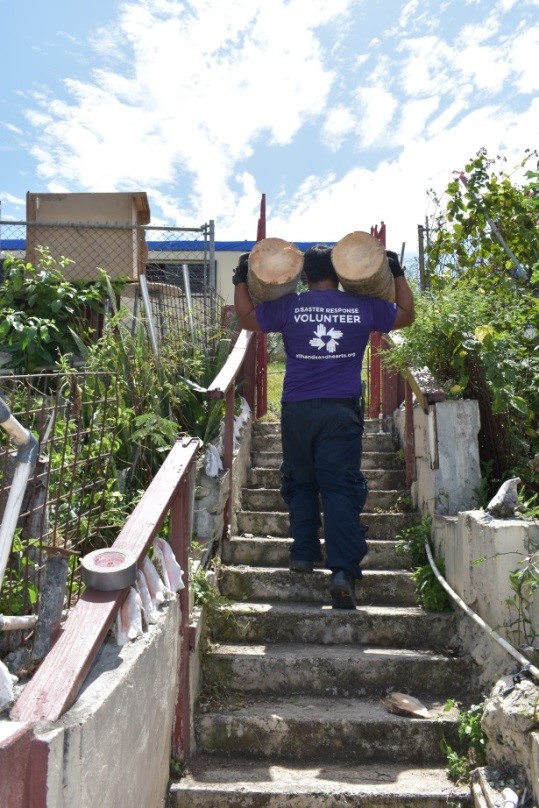
The homeowner, Miss Glenda was with us all day and was so grateful for everything we did. Her home, like most of the homes I had worked on, seemed almost not possible when we started. She warned us that her cat had kittens and the kittens were probably in the piles of debris somewhere. Nothing like ramming a shovel into a pile of nasty hurricane-damaged debris and skewering a baby kitten, I thought. We were all really careful and around mid-morning, I lifted a shovelful of debris and a little orange kitten crawled out of a hole in the pile of debris. She had five brothers and sisters in the pile and I scooped them up and moved them all to a box at the other end of the front porch. The momma cat kept an eye on us, as did Ms. Glenda’s dog who acted like he was the kittens’ father. The skittish dog kept an eye on us for the rest of the day.

When we were almost finished for the day we were promised a quickie trip to the beach if we finished early. I stunk. Really stunk, as make-you-want-to throw-up stunk. Not just from my own sweat, but when we had moved a refrigerator up the front steps, funky gook had oozed onto my pants and boots, as well as completely stinking up the steps for the rest of the day. It was incredibly foul. Gag foul. People had been instructed to not open their refrigerators if they had been closed for more than 5 days after the storms. This one had been closed since Irma, September 2017. We could hear the food moving around inside as we heaved and hoed the fridge up the stairs. It took four of us. Two upstairs from the fridge with a strap and two behind the fridge pushing. Ian, the crazy Englishman, did the counting, “One, two, three…go,” and we’d heave one step. Then it was, “One, two,…go!”, then it was no counting, just “Go, Go, Go, Go,…” and we hoofed the horrible smelling appliance to the roadside where it would be separated to the appliance pile. But it got me. Six-month-old Caribbean-heated food-rot ooze had spilled on me and I could not stand the smell of myself.
So my plan, if we got to the beach would be to walk straight into the ocean, with pants, shirt, boots, everything on. Just to try to rid me of some of the funk in the turquoise sea, probably leaving a slick behind me like a garbage barge.
Ian pointed out an iguana on a nearby powerline where some linesmen from Georgia were installing new electrical power lines. That kind of stuff was our entertainment.
And then we heard Miss Glenda ask to save an avocado tree in the back yard. She said her mother had planted the tree years ago and the only thing her mother had cried about after the hurricanes was when she saw that the storm had flattened her tree. But leaves were still green in the canopy that lay in the back yard. I chopped rock-hard earth with a pick-ax to create enough of a hole that if we could upright the tree there might be hope that we would be able to restore it to its former glory. Jason pulled with a strap and Pamela and I pushed and straightened the tree back up. We built a tripod of scrap 2” x 4”s around the base, roped them together with the rope we had found under a pile of roofing debris, and back-filled the hole. Ian had painstakingly cut notches in the 2” x 4” to anchor the tripod.
An elderly, bedridden man, that I didn’t even know was in the house had been watching the operation. “There’s water,” he said through slats in the window very close to me. I peered through the slats and his eyes were gray-white like he was fully blind, but he could somehow see or knew what was going on. “Water in the barrel and in the bucket…over there.” He pointed. I found the five-gallon water bucket he intended me to find and dumped it around the base of the family avocado tree. The rock-hard soil gulped the water down and the surface of the soil was dry again within a minute. But the tree looked like it might have a chance. The AHAH crew all signed the tripod posts and we showed the homeowner. She was incredibly grateful and gracious. All and all, it was a really good day.
Days rolled into a week, then a second. It seemed like time slowed like when I travel, seeing new things, meeting new people, and I was tired at the end of every single day. The work was amazing.
I got assigned another mess of a home and got to work with Lady Catherine and Maddie again. Our TL, Caleb, was a really good guy, and we had a couple from Oregon working with us, Anya & Tyler (left pic), who was super likable and Tyler had an amazing music playlist with oldie classics from Van Morrison, Little Feat, James Taylor, as well as newer stuff from the Woods Brothers, Florence, and the Machine, and others. I knew the words to nearly every song on his playlist and loved being on the crew with him. Good music just makes hard work so much easier and better.
It was cool that this young married couple was able to take time and do this kind of volunteer work together. Tyler knew about Grant’s Pass, Oregon where my daughter Carly’s friends have their little pot farm, and Anya and Tyler were just good, beautiful people.

We had a sick (pun intended) amount of moldy walls inside the home we were working on, so it was P-100 mask-work the whole time. Our joke was that the walls were made of the mold with a little sheetrock holding them together. I worked with Maddie and we knocked out black moldy wall after black moldy wall in one room while Catherine and Anya did the same in another. Tyler was back and forth scrambling high on walls and tearing the bathroom apart with a vengeance.
The home site was on a cliffside and had a 30’ drop off at the back. It was another hike to the dumpster on the front street. We got the site cleaned up in three days with the help of the homeowner, Austin, who worked with us every day.

The entire All Hands and Hearts crew would get Wednesday afternoon off during my last week, to celebrate the completion of Little Blossoms pre-school. I had worked there one day, with Scott, putting on metal roof panels, but the project had been going for several weeks and the small schoolhouse had been entirely gutted and rebuilt. Ed, from New Jersey, had been on site there every day and would be heading back home the next day. I met with Ed just about every day for a little talk, about work, about life, about home. He was Jersey from his accent to his attitude, no bullshit, and super nice. He was also passionate about the Little Blossoms job and very excited to see it completed before he left.

We had a hot dog/hamburger cookout and our normal 8-hour day ended at 12:30. I had been working the last day and a half with Tyler (yes, with music!), Zak, and Laura at the middle school, cutting and putting up new walls. Laura had worked with a number of volunteer programs, had been married for 40 years, and was quite capable of power tools. She and Ed were both closer to my age than anyone else and had put in the most time at Little Blossoms. It was their baby, but also a big photo op for All Hands.
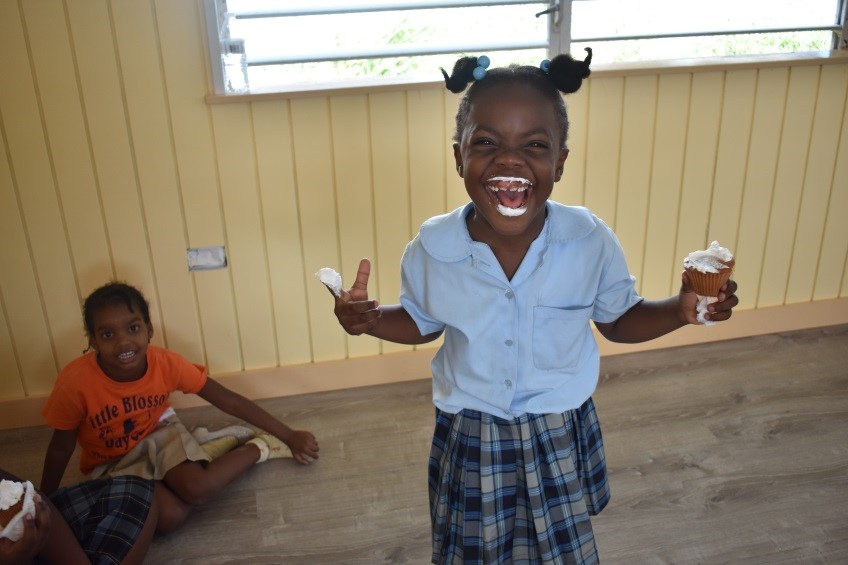
Kids and families were invited to the completion party and there were delicious cupcakes enjoyed by the kids.
I had the option of spending my last day on the island going to the beach, or tagging along with Amie to visit homeowners she had met and became friends with during her assessments. She would be flying out the same Monday as me and invited me to go with her.
We stopped first to visit Clay and Esperanza. Clay is an ex-pat American and his wife Esperanza is originally from the Dominican Republic. Their cliffside home was featured in the All Hands promotional video. Check it out.
-eemphasizing the 6 months anniversary of the storms and the cliffside area looked like something you would see near Monterey, California. An incredibly sweet place to watch a sunset. The couple had moved to a home only three doors down that had weathered the storms. Their home was basically gone. Clay told me that he and his wife had holed up in the back of their kitchen area when he heard popping noises and figured the old deck at the side of his home, a deck that he had planned to dismantle and get rid of anyway, was probably coming loose, “Figured I wouldn’t have to worry about taking it apart,” he told me with a smile, but it wasn’t just the deck, it was the entire front of his home and roof that was flying off, and he is the one who watched his bed lift up and fly into the ocean like a magic carpet. Their freezer had also flipped in the storm and three frozen turkeys went flying, never to be seen again, like frozen bombs flying across the sky.
Clay pointed across the bay, to two large deck-like structures laying on the side of the hill, “Pretty sure that’s my roof over there,” he said pointing to the structures. It looked like a gable roof that just all lifted at the same time, flew the length of two or three football fields, nd landed upside down, largely intact. It was unbelievable and probably more than a ton of wooden roof structure. Esperanza made us the best cup of coffee that I’d had in three weeks. Amie spoke with them about options for assistance with repairs since AHAH had done all they could do with clean up. Clay and Esperanza had been trying to purchase the property that had been destroyed, but most homes in St. Thomas are family-owned with every family member having some portion of ownership, which makes getting a clean title almost impossible. It was obvious to me that these islanders were happy to be alive and were trying to be patient, but were also frustrated by the past six months with little happening to their home, except for an extensive All Hands clean-up. Their rebuilding project would go on long after I left the island.
The night before Amie had stopped at a grocery store, the best-stocked store on the island, to pick up food for one of her islander friends, an 82-year old blind man named Nehemiah. He was our second stop. The road to Nehemiah’s home was the worst I had seen on the island. Two-foot deep ruts and even deeper holes in the earthen road. Amie’s rented Ford Fiesta was as badass as a Ford Fiesta can get, and barely managed to get us to his home.

Amie called out, “Mr. Nehemiah!” A half dozen times and then we climbed steps to his shack of a home. The front door was wide open. “Mr. Nehemiah, it’s Amie from All Hands!” And we heard a voice. We waited at the open door for a small black man to emerge from the back of the home. His radio was playing in the back room and it was easy to understand why he hadn’t heard Amie’s earlier calls.
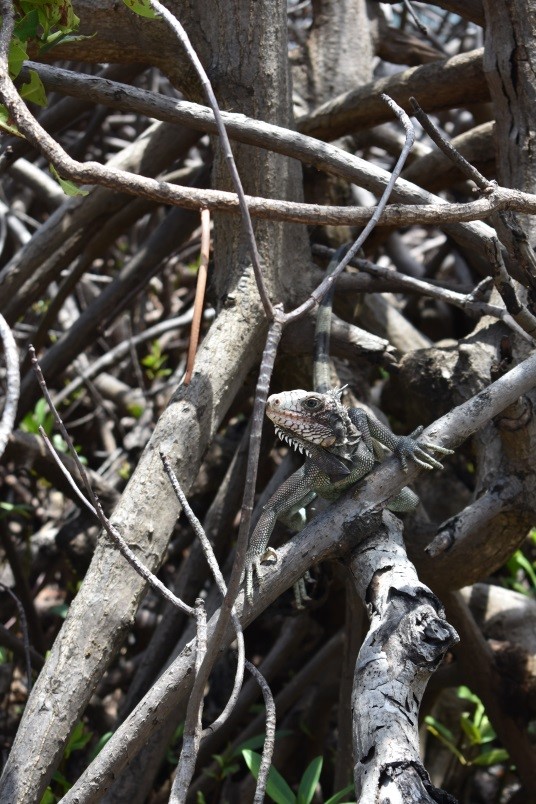
“Come in,” he said a barely audible voice. Mr. Nehemiah walked with a cane, wore black glasses as you’d see on Ray Charles. He was small and wiry, and slow. But he moved toward us.
“It’s me, Amie, Mr. Nehemiah, and I have brought a friend with me. His name is Josh,” she said extending her hand into his.
“Jos??” he asked.
“No, Josh…Joshua, like in the Bible,” Amie explained and I reached for his hand as he understood my name and smiled.
“Joshua,” he said and looked directly at my face from the sound of my voice. We unloaded the food on his table. Amie knew Mr. Nehemiah got certain canned vegetables, beans and tuna, and such from the Catholic Charities, but he had told her that he really liked fresh fruit and vegetables. She had gotten tomatoes, cucumbers, strawberries, a carton of lemonade, and his favorite blueberries, among other things. The bags of goodies must have cost her about two and half times as much as they would at my Gainesville Publix. $8.99 for a pint of blueberries, for example. Everything except for rum costs more here. Usually two and half times as much.
We offered to stow his groceries away in a new fridge that he had just gotten (note six months after the storms), but he said he’d prefer to do it himself since he would then know what was where.
Mr. Nehemiah’s home has been muck and gutted by All Hands. All interior walls were 2”x 4” frame, no sheetrock or paneling, just frame walls with electrical wires strewn through them. No nails or screws were sticking out of the framing lumber, all removed by the AHAH crew.
Mr. Nehemiah was an electrician and even blind, had been working on the wiring his home. He had hard-wired his new fridge with no outlet. He would apparently hook-shape the bare hot wire, twist the neutral, and leaves the ground straight so he could feel/discern between the three different wires. All Hands had been effective but pulled some of the wirings out of the walls that left hot and neutral wires “feeling” the same. Clay, from our earlier visit, as a master electrician and Amie asked if he could look in on Mr. Nehemiah and check the wiring. He said he would. That seemed like the island way to get something done and Amie had been on the island for months and knew the protocol.
While we were visiting, Amie also programmed a new flip phone for Mr. Nehemiah and paid for his next month’s service, including international calls so Mr. Nehemiah could call his daughter in St. Kitts. I marveled at the gentleness of this old man as we talked while Amie did the phone magic.
“God looks out for me,” he said. And I couldn’t help but be struck by the magnitude of what he said. This frail old man in dark sunglasses that were now pulled down and hanging crookedly from one ear and down to his chin, living in a home with just frame walls, sleeping on a couch in the only room that didn’t have a leaky roof, happy to have company for the sake of conversation, smiling at me, a stranger that he’d never see, but had welcomed into his home. My first thought was, “God has forgotten about you!”, but that wasn’t the case. He had people checking on him, kind souls like Amie concerned, nd making sure he wasn’t forgotten after she left the island. Catholic Charities made sure he had food, and even if he was lonely, he wasn’t alone.
“God looks out for me,” he repeated and smiled. It was easy to see how fond Amie was of this sweet old guy, and how much he appreciated and liked her while maintaining his own sense of independence. He enjoyed our company and it was impossible not to like this man.
Mr. Nehemiah only actually asked for help once. He said he had a hard time locating the #1 on his phone. “If I find number One, then I know where Number Three is, and the Number 7 and Number 9, at the corners, so I know all the numbers, but sometimes it is hard to be sure I am on Number One.”
So we put a tiny piece of duct tape over the Numbers 1, 3, 7, and 9, the corner digits on his flip phone. I knew the tape would not stick for long, but it was a good start and easy for him to feel the tape. Before we left, Mr. Nehemiah was able to call his nephew who lived on the island, and Amie programmed that number into his phone. All of Mr. Nehemiah’s phone numbers had to be logged away in his 82-year old brain. I was amazed that he was able to recall 10-digit numbers.
Our third stop of the day was another damaged home that Amie had first assessed, then checked back on, and wanted to see before she left. Her connection with every damaged home was with the homeowners, the disaster victims. She would assess the property for All Hands to work on but dutifully found out about the owners and the situation in each and every home she assessed. Our 3rd visit of the day was now after 5:00. We had been planning to visit Stop #3 by 2:30 or 3:00.
The owner was named Mario, a man who Amie had learned had lost his husband in 2017, prior to the hurricanes. Amie had made a strong point to the All Hands crews that they needed to understand how delicate the muck and gut must be, that Mario’s husband had done much of the work inside the home and how important it was that the crews made sure before tossing anything out that it was not something of great sentimental value to Mario. That was tricky but vital to the clean-up operation. mie’s trainee/protege was an assessor named Nora and Mario expressed how grateful he was for her gentle kindness toward him. Kindness projected through her own 20-year old energy. “She saved my life,” Mario said.

We shared drinks at Mario’s home that was now habitable. Mario had opened his home to a young AmeriCorps volunteer who was working with a learning-disabled group on the island. Christian has arrived on the island Sept. 5 and on his birthday, Sept. 6, Irma struck. Two weeks later, Maria.
“You have horrible timing, dude!” I joked. “No shit,” he smiled back at me.
“I have been here ever since, now a bit over 6 months, except for 6 weeks when I had to go back to the Mainland to take care of my dad when he got sick. It would have been easy just to stay on the Mainland, and just turn my back on this island, but I made a commitment to AmeriCorps and a bigger commitment to my work and the people here, so here I am. Mario lets me live here for almost nothing and I take care of things when he is gone. It works.” I could see that the island and its people had seeped into Christian’s soul as they had with Amie.
Mario is a total exclamation point, told me to be sure to celebrate my “fabulosity!” and considered himself the Maharajah of Smith Bay, the section of St. Thomas where he lived. We talked about life, age, time well spent, and the hurricanes. He was as welcoming as Clay and Esperanza and/or Mr. Nehemiah, had been earlier in the day. Mario’s welcome was just utterly more flamboyant!
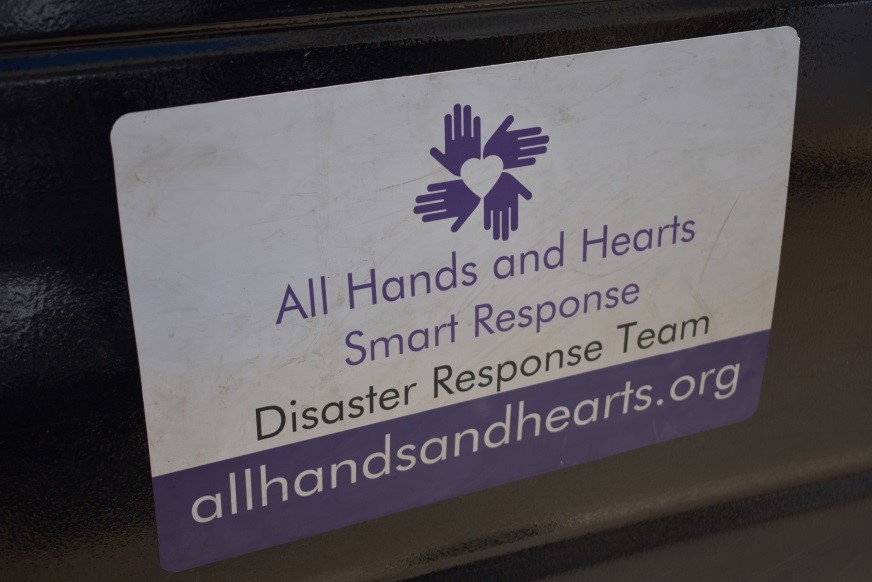
Flying back to the States and doing my “re-entry” to normal life is always an adjustment. It was an adjustment after my five-week Colorado Trail hike, it was tough adjusting after traveling all over the western United States with Carly last summer, but it is always good to get home to Leslie, my own bed, and my dogs. I missed three weeks of my granddaughter Harper growing up and gaining an ounce a day in Tallahassee as all good strong babies should. But time had slowed for me in the islands. Every day was a new adventure and the vibe was incredibly good.

I was recommended a book by Rebecca Solnit entitled, “A Paradise Built in Hell…the extraordinary communities that arise in a disaster” which she details not just hurricanes and natural disasters, but the Blitzkrieg World War II bombing of London, 9-11 and New York City in its aftermath, an explosion that rocked Halifax, Nova Scotia, earthquakes that rocked Mexico and San Francisco, and other disasters that have shaped our history. Her basic conclusion was that if it was left up to Hollywood movies, human nature would always be mad with fear and bring out the hero in only a select few. But the fact is that human nature during disasters is an incredible force of its own. Disasters that affect entire communities create a lifetime bond and can bring out the most heroic, energetic, selfless, and best in communities, despite the of life or grievous hardships. Disasters can also bring the looters and bring out the worst in some, but history has shown that far more often, it brings out a common empathy and equality when people go through the same hardships. It can bring out the very best in people.
I traveled to Boston for the first time in my life in 2017 and there is still an ever-present “Boston Strong” feeling in the city. A collective, “You can bomb our marathon, you can even kill and maim some of our people, but you will never, ever defeat us,” spirit. A similar, but even stronger spirit lives in New York City and has since 9/11/2001. Walking by Fire House 10, right across from the World Trade Center in 2016, I watched a strapping young fireman who looked to be about 25 years old posing for photos with tourists. I figured he was maybe 10 years old during the 9/11 bombings and probably a New Yorker, through and through. He may or may not have been nearby when the bombings happened, but it was easy to see how proud he was to stand in the footsteps of the heroes who perished that day and could well be called to run into Hell when everyone else is running out. And New York City, its residents, nd visitors from all over the planet, swell with pride that the city not only survived that day but thrives.
Disasters are part of our lives. Personal disasters, injuries, illnesses, loss of jobs, divorces, and all sorts of other things can no doubt take a catastrophic toll on people and often we go through these personal disasters alone or in a small group. Human nature tells us not to delve into other people’s disasters too much and as individuals, we suffer.
Community disasters, however, can take on a different commonality and can bring communities together and bring about positive changes, from a general neighborly brotherhood, to bold civic pride, to new, better building codes, to a common fight against the rise of someone like Adolph Hitler, and to social revolution. The common strength of a community cannot be underestimated and it seems that disasters level the field, at least for a time, where race, social status, money, and religion can take a backseat to brotherhood. It is never to say that tragedies during disasters are not still horrible, but that recovery after disasters can restore much more than just a home or landscape.
One of the beautiful things about being involved with All Hands and Hearts was that the people of St. Thomas, USVI welcomed us, welcomed me into their community. I became an honorary member, even though I had not been on the island during either of the catastrophic storms. I did not live through the storms, but heard the stories, and was one of many who worked very hard to help clean up the mess left in the hurricanes’ aftermath. And for me, I feel I got more from the experience than I gave. I go into a volunteer project like this having faith that I will get more than I give. In that sense, for me, volunteering is oddly a selfish act.
Rebecca Solnit cites a book about altruism and democracy, “The Samaritan’s Dilemma” by Deborah Stone, “From the voice of altruists, a more remarkable paradox emerges: Most people don’t experience altruism as self-sacrifice. They see it as a two-way street, as giving and receiving at the same time. When they help others, they gain a sense of connection with other people. Giving and helping make them feel a part of something larger than themselves. Helping others makes them feel needed and valuable and that their time on earth is well spent. Helping others gives them a sense of purpose.”
For my family and friends that donated over $3000 for All Hands and Hearts before I left Florida, I hope that my experience will confirm that your donation was well spent. Incredible progress is made every day with an ever-changing group of volunteers and dedicated staff. The work that AHAH does is vital and important. It can also be life-changing, for the victims of disasters and for the volunteers like me.
Like the vegetation on the island that had been fighting to grow another season, there were bright spots of beauty all over the island. The mountainsides were turning green again. Even twisted, broken trees were sprouting leaves and flowers were growing from decimated hillsides. The beaches were clean. People were smiling and Life was going on. I got a chance to meet inspirational and gentle islanders, who had maintained a strong sense of faith and, in most cases, a beautiful sense of humor. I heard devastatingly sad stories and I heard raucous laughter. I met a crop of hard-working millennials and volunteers of all ages, from all over the world that just plain dug in to help. They all gave me hope that the best we have to offer during our human experience is yet to come.
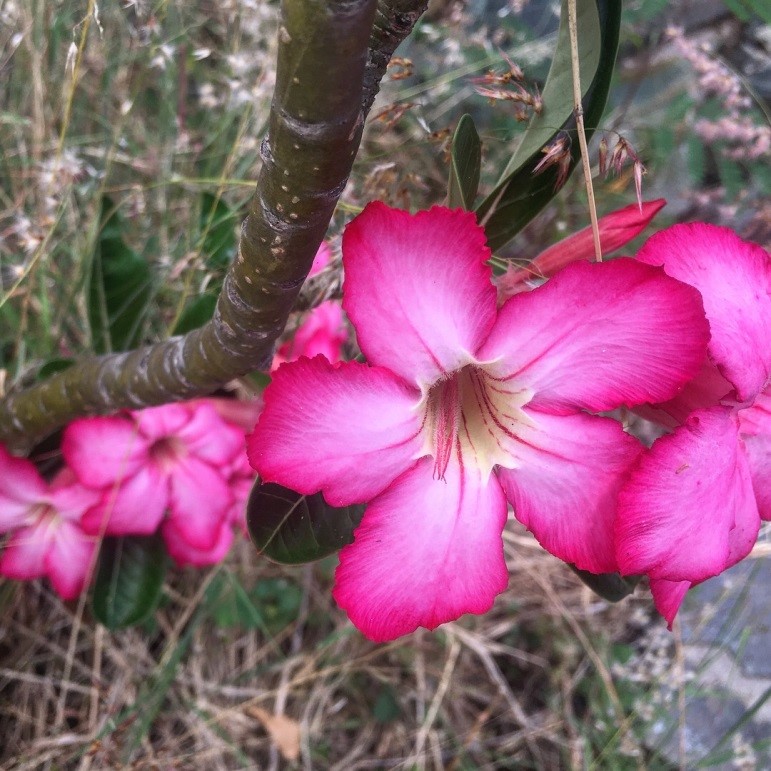
~ Josh Hellstrom
March, 2018
All Hands and Hearts Update:
In 2019, I spent two weeks working with volunteers in the Panama City, Florida area cleaning up the devastation after Hurricane Michael swept through the area. As a Florida resident, I was appalled at how little I knew about the devastation. Millions of acres of downed trees, and blue-collar areas in ruin from the Florida coast to Georgia. All Hands and Hearts spent months dealing with tree removal, muck and gut operations, and help for local citizens.
Because of the Covid-19 concerns around the world, volunteer operations have been suspended at all All Hands and Hearts operations until further notice.
If you liked this post, check out So You Want to Hike the Colorado Trail?
